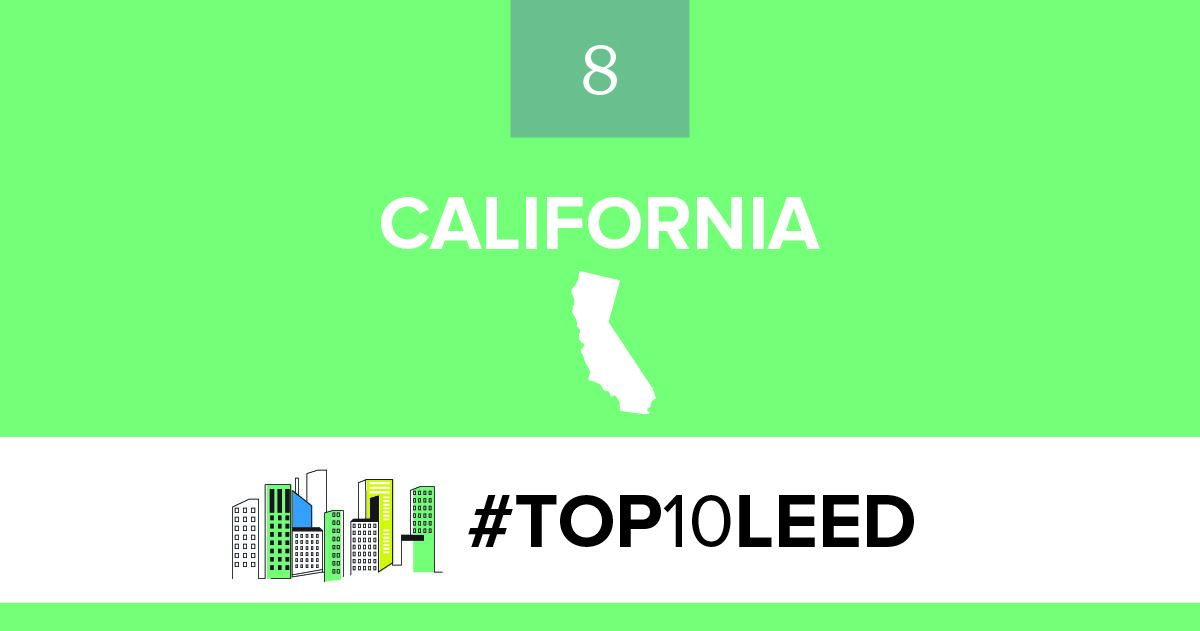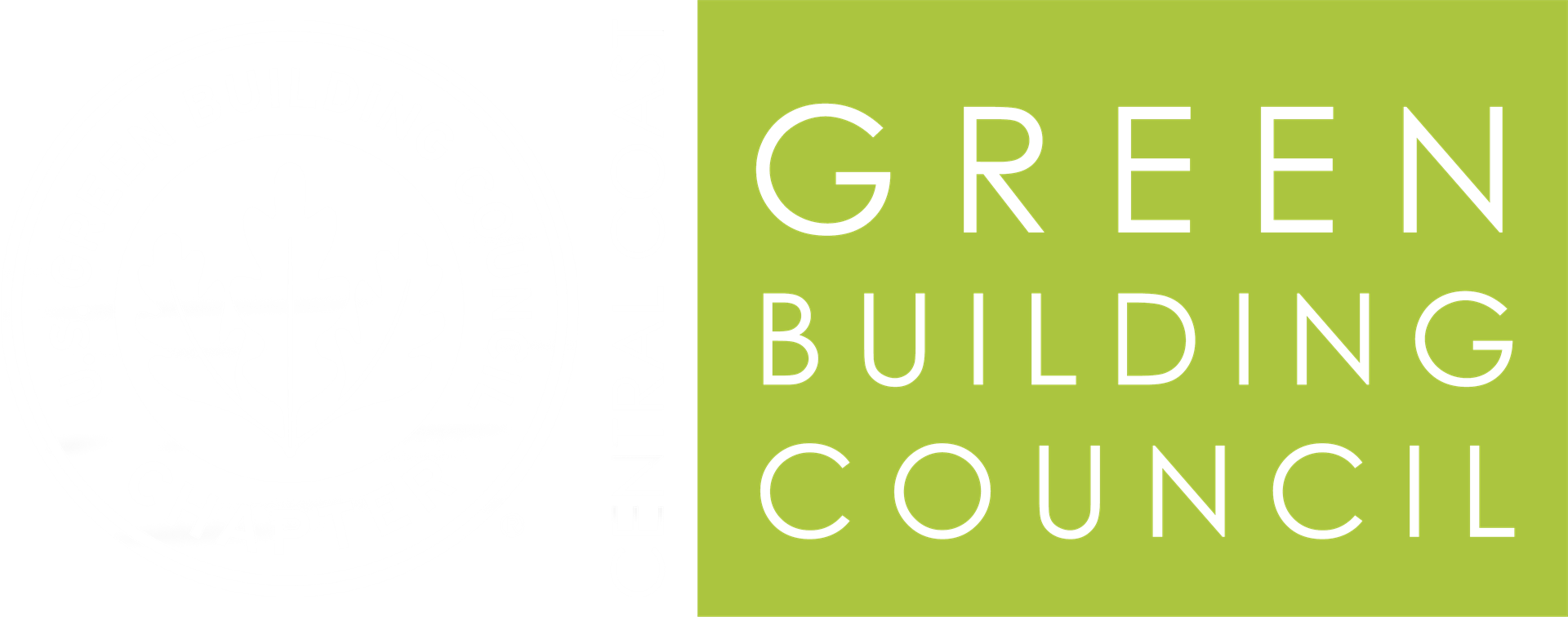
The U.S. Green Building Council (USGBC) has released its annual list of the Top 10 States for LEED (Leadership in Energy and Environmental Design), the most widely used green building rating system in the world. This year, California ranked eighth in the nation.
This is the seventh year in a row California has been included on the list, indicating its steady and continual leadership in advancing green building across the state. The list is based off the square footage per capita from commercial and institutional green building projects that were certified throughout 2017. California certified 475 projects representing almost 90 million square feet of space. These projects equal 2.4 square feet of space per capita over the entire year.
LEED-certified spaces use less energy and water, save money for families, businesses and taxpayers, reduce carbon emissions and create a healthier environment for occupants and the community at large. LEED supports state and local strategies to mitigate climate change and increase sustainable development.
About LEED
- LEED, or Leadership in Energy & Environmental Design, is a globally recognized symbol of excellence in green building.
- LEED projects earn points by adhering to prerequisites and credits across a series of categories including, but not limited to, energy and atmosphere, materials and resources, and indoor environmental quality.
- Based on the number of credits achieved, a project earns one of four LEED rating levels: LEED Certified, LEED Silver, LEED Gold or LEED Platinum. The LEED rating systems work for all buildings at all phases of development and is meant to challenge project teams and inspire outside-the-box solutions.
- LEED-certified spaces use less energy and water, save money for families, businesses and taxpayers, reduce carbon emissions and create a healthier environment for occupants and the community at large. LEED is a tool for economic development and supports state and local strategies to mitigate climate change.
- More than 40,000 commercial and institutional projects are currently LEED certified worldwide, comprising more than 6.5 billion square feet of construction space in all 50 states in the U.S. and in 167 countries and territories globally.
Top 10 States for LEED 2017
- The annual Top 10 States for LEED is a ranking of U.S. states that have achieved the most square footage per capita of LEED-certified space in the past calendar year.
- The list draws attention to states throughout America that are making significant strides in sustainable design, construction and transformation at the building level, and also opens up conversations around community and city-level accomplishments in sustainable development.
- Now in its eighth year, the list is based on 2010 U.S. Census data and includes commercial and institutional green building projects that were certified throughout 2017.
- Collectively, 1,399 commercial and institutional projects achieved LEED certification within the top 10 states in 2017, representing 314.73 million square feet of real estate. Nationwide, 2,647 commercial and institutional projects achieved LEED certification in 2017, representing 484.56 million square feet of real estate.
- The full list of the top 10 states can be found below:
|
2017 Top 10 States for LEED
|
|
Rank
|
State
|
Certified Gross Square Footage (GSF)
|
GSF Per Capita
|
Number of Projects Certified
|
|
1
|
MA*
|
29,338,378
|
4.48
|
130
|
|
2
|
NY*
|
65,749,387
|
3.39
|
192
|
|
3
|
IL*
|
43,363,065
|
3.38
|
135
|
|
4
|
HI
|
4,519,757
|
3.32
|
16
|
|
5
|
MD*
|
15,854,679
|
2.75
|
105
|
|
6
|
MN
|
13,018,056
|
2.45
|
47
|
|
7
|
GA
|
23,638,051
|
2.44
|
71
|
|
8
|
CA*
|
89,258,519
|
2.4
|
475
|
|
9
|
VA*
|
18,589,482
|
2.32
|
152
|
|
10
|
CO*
|
11,397,964
|
2.27
|
76
|
|
**
|
DC
|
23,966,817
|
39.83
|
139
|
- * Included in 2016 Top 10 States for LEED list
- **Washington, D.C. is not ranked, as it is a federal district, not a state
California Statistics for 2017
- State leadership and local policy initiatives make California a model for green building across the country.
- The structure and rigor of the statewide green building code, known as CALGreen, acknowledges the stringency of codes for many projects throughout California and provides a significantly streamlined effort for projects seeking LEED certification. CALGreen, coupled with LEED, creates incentive for more projects to exceed code minimums voluntarily.
- · In California, a total of 475 projects, totaling more than 89 million square feet, earned LEED certification in 2017, representing 2.4 square feet of certified space per capita.
- Key projects certified in 2017 include:
- San Diego Rental Car Center, owned by the San Diego Regional Airport Authority, was the largest project certified in California in 2017 and achieved LEED Gold;
- Bren Hall, a classroom and laboratory building on the campus of the University of California, Santa Barbara, earned the highest LEED score of any project in the U.S. in 2017 with 93 points and achieved LEED Platinum;
- Loma Linda Veterans Affairs Clinic, a health care center serving veterans in Southern California in an environment that promotes physical and mental rehabilitation achieved LEED Silver;
- 23andMe, the human genome testing service with over 2 million users around the globe, has state-of-the-art laboratory and office facilities based in Mountain View achieved LEED Platinum; and
- The Perkins+Will San Francisco office, providing a healthy work environment for designers and architects creating some of the most sustainable buildings in the city, achieved LEED Platinum.
Article provided by USGBC National

